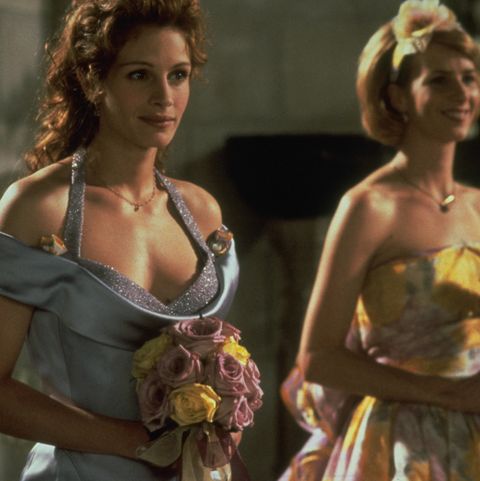
Ronald SiemoneitGetty Images
Let the record show that, in My Best Friend’s Wedding, George (a divine Rupert Everett) flies from New York to Chicago twice in two days to try to salvage the mess that Jules (Julia Roberts in a career-best tornado of a performance) has made. Twice! In two days! Just going to LaGuardia, breezing through the gates where people are smoking everywhere because it’s 1997 and—apparently—there were no rules, hopping on a plane to O’Hare, coming back and then doing it again, this time in a tux, the next day. And George isn’t even the titular best friend! That title belongs to Michael (Dermot Mulrooney, dreamy), whose impending wedding sends Jules into a tailspin that engulfs everyone around her. Everyone in this film is doing the most, ostensibly for love (this is a rom-com after all), but really for that most evanescent of all things: adult friendship.
Let the record further show that, although I have watched My Best Friend’s Wedding upwards of 30 times in the 23 years since it came out, the absurd particulars of George’s travel itinerary never stood out to me until last night, when a casual observation by my friend Ever sent me reeling. We were watching the movie the same way I’m doing a lot of things these days: Together but apart, linked by Google Hangouts. We’d pressed play (them on Hulu, me on the DVD I’ve been carting from apartment to apartment for two decades) at the same time and worked hard to sync the sound to create as seamless and stereophonic an experience as possible.
When presented with the chance to re-watch the film for this piece, I took the opportunity to also try to maintain some semblance of social connection with a new friend. You see, we met a few weeks ago and hit it off and decided we should be friends and—in a remarkable feat for adults in the present day—we actually made and kept a plan to grab dinner together. At the end of the dinner, we did that thing where you say to another person, “We should be friends—no actually, I mean it. We should text each other and hang out and not do that thing where we say we’re going to do it but life gets in the way.” And we meant it. And so we did text. And then a week later the gravity of a pandemic hit home and things started closing and soon we were sequestered in our separate homes less than a mile apart for weeks.
It was apropos, perhaps, that we were enacting a long-ish distance, fun house-mirror version of social bonding through co-watching My Best Friend’s Wedding, a film that flips the conventions of connection, and rom-coms in general, on their heads. As Jules confesses close to the climax of the film, she’s the bad guy. But it’s through her eyes that we see the events play out, and she’s played by The Julia Roberts, so there’s always a small part of the viewer that wants her to win. This despite an absolutely winning crème brûlée of a performance from Cameron Diaz as Kimmy, Michael’s fiancé. It’s no coincidence that the music swells dreamily when Jules, not Kimmy, finally kisses Michael in a sun-dappled gazebo on his wedding day. Everything about the scenario is backwards, but the movie works incredibly well anyway.
The fact that My Best Friend’s Wedding is like a photo negative of a traditional rom-com gives director P.J. Hogan license to introduce delightful absurdities and digressions that would derail another film. In a normal rom-com, whatever chaos surrounding the central couple boils into a concentrated push to get the two leads together. In My Best Friend’s Wedding, the chaos pushes everyone apart, and in the vacuum that creates, Hogan welcomes a Dionne Warwick sing-a-long, theft of a bread truck, and an Orange Is the New Black precursor in the women’s bathroom at Comiskey Park.
The film takes a familiar romantic setup and looks at it from a foreign angle, which opens everything up to possibility. For the characters this can seem close to ruinous: Jules stands to lose her best friend, Michael stands to lose his marriage and his job, and the restaurant Barry the Cuda’s stands to lose its cabaret license after an authorized “Say A Little Prayer” sing-a-long. But for the filmmaker and the audience, there’s so much more to gain by briefly setting aside the recognizable and exploring the unknown.
For instance, the space in the narrative allows Hogan to introduce delightful and strange moments of queer coding and overt queerness in a film that’s ostensibly about one-to-three straight people ending up together. George was one of the first—if not the first—gay character I saw on the big screen, and I joked to Ever that I learned from George’s arc that adult gay life was comprised of going to book readings, having dinner parties, and flying places on a moment’s notice. They replied, “Uh, that’s what your life is.” Which… fair. That’s what my life once was and will be again. Right now it’s Google Hangouts movie nights and Zoom happy hours and calls on an actual cell phone like I’m a late-’90s rom-com villain played by America’s Sweetheart. None of it is the same, but, in the best light, it all offers new opportunities to be creative, to reach out, and to make a friend.

